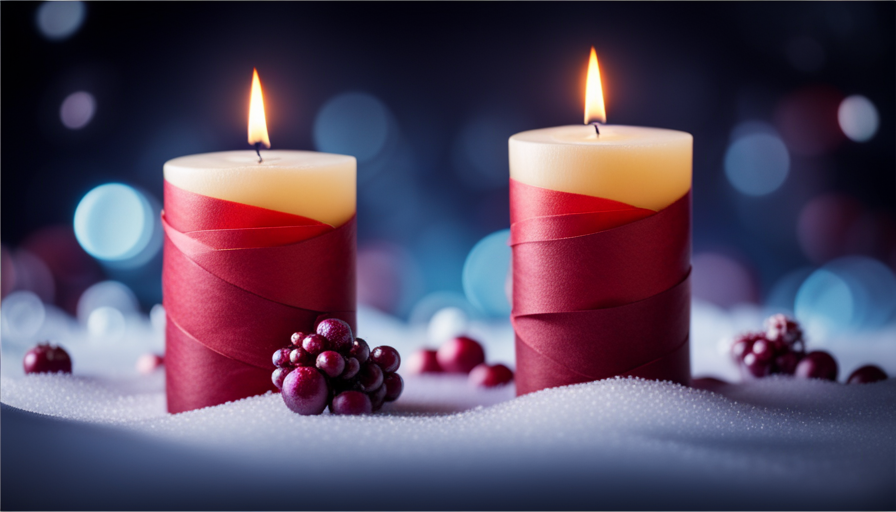You find yourself in a situation where you need to wrap a candle in gift wrap. It’s the little joys and obstacles that life presents! Fear not, my brave friend, as I am here to guide you through this fun task with a touch of humor and wisdom.
Now, one might think that wrapping a simple cylindrical object like a candle would be a piece of cake. Oh how wrong they are! Wrapping paper has a mind of its own, it twists and turns and rebels against our attempts at taming it. But fear not! With my expert advice, you will conquer this seemingly insurmountable task with finesse.
First things first, gather your materials – the beautiful wrapping paper of your choice (preferably one that won’t burst into flames), scissors to cut said paper, and of course, the star of the show – your elegant candle.
With measured precision, cut the wrapping paper to fit snugly around your beloved candle. Don’t forget to leave some excess on both ends for that perfect finishing touch!
Next comes the delicate art of folding and securing the edges. Be gentle yet firm as you fold over each end and secure them with tape or an adhesive of your choice.
But wait! We can’t stop there; we must add some decorative embellishments to make this gift truly shine. Ribbons? Check. Bows? Double check. Tinsel? Why not?
Lastly, personalize your gift by adding a thoughtful note or perhaps even wax sealing it like they did in ancient times (just kidding… unless?).
Remember dear reader, presentation is key! So go forth with confidence and wrap that candle like no one has ever wrapped before. May your gift bring joy and light into someone’s life as much as this article has brought amusement into yours. Happy wrapping!
Key Takeaways
- Choosing the right wrapping paper that complements the candle’s design is important.
- Adding decorative embellishments like ribbons, bows, and tinsel enhances the overall look.
- Cutting the wrapping paper to fit snugly around the candle, leaving excess on both ends.
- Personalizing the gift with a thoughtful note or wax seal adds a special touch.
Gather Your Materials
Now, before you can begin the fun and creative process of wrapping your candle, you’ll need to gather all your materials.
Choosing the right wrapping paper is essential to make sure your candle looks elegant and stunning. You can select a patterned paper that matches the occasion or opt for a solid color that complements the candle’s design. Adding a personal touch is also important, so consider using ribbons, bows, or even small ornaments to enhance the overall look.
To start with, find a flat surface where you can work comfortably without any distractions. Lay out your chosen wrapping paper and make sure it is large enough to cover the entire candle. If not, you may need to trim it down later.
Next, measure and cut the wrapping paper based on the size of your candle. This step will ensure that your wrap fits perfectly around it.
Once you have gathered all these materials and completed the measuring and cutting process, you are ready to move on to the next step: preparing your candle for wrapping.
Measure and Cut the Wrapping Paper
First, grab a ruler and scissors so you can measure and cut the perfect size for your candle gift. Measuring techniques are crucial to ensure that the wrapping paper fits snugly around the candle, creating a polished and professional look.
Start by measuring the height of the candle using the ruler. Then, wrap the ruler around the circumference of the candle to determine how much wrapping paper you’ll need.
Choosing the right wrapping paper is equally important. Opt for a sturdy paper that isn’t too thick or too thin. You want it to be durable enough to withstand handling but also flexible enough to wrap smoothly around the candle. Consider using patterned or textured papers to add an extra touch of elegance.
To emphasize these points, here are four tips:
- Measure twice, cut once: Take accurate measurements to avoid wasting any wrapping paper.
- Account for overlap: Add an extra inch on each side to allow for overlapping when wrapping.
- Test before cutting: Place your candle on top of the uncut wrapping paper to ensure it covers completely.
- Coordinate colors: Choose complementary colors for both your wrapping paper and ribbon.
With your perfectly measured and cut wrapping paper in hand, it’s time to move on and wrap your beautiful candle gift seamlessly.
Wrap the Candle
To achieve a flawless presentation, carefully encase your candle gift in the perfectly measured and cut wrapping paper.
Now that you have your beautifully cut paper ready, it’s time to wrap the candle with precision and style. Candle wrapping techniques can elevate the entire gifting experience and make it truly memorable.
Start by placing the candle on one corner of the wrapping paper. Gently roll the candle over the paper, making sure to create a snug fit. Fold one edge of the paper tightly around the candle, securing it in place with a piece of double-sided tape or a small dab of glue.
Next, fold in both sides of the wrapping paper towards the center of the candle. This will give your package a neat appearance and ensure that no edges are left exposed. Secure these folds with tape or glue as well.
Now comes the fun part – creative packaging ideas! You can add decorative embellishments such as ribbons, bows, or even dried flowers to enhance the overall look. These additional touches will give your wrapped candle an extra special touch and make it stand out among other gifts.
With your candle now expertly wrapped and adorned with beautiful accents, you’re ready for our next step: adding decorative embellishments that will truly make your gift shine.
Add Decorative Embellishments
Once you’ve achieved a flawless presentation, it’s time to enhance the overall look of your beautifully wrapped gift by adding decorative embellishments. These creative adornments will take your candle wrapping to the next level and make it stand out from the rest.
You can choose unique embellishments that match the recipient’s personality or the occasion you’re celebrating. For example, if you’re giving the candle as a birthday present, you could attach small party hats or mini balloons to create a festive atmosphere.
To add a personal touch, consider using customized ribbons with the recipient’s name or initials printed on them. This not only adds an element of surprise but also shows that you put extra thought into their gift.
Additionally, incorporating themed elements like tiny seashells for a beach-themed candle or miniature pinecones for a winter-themed one can make your gift truly memorable.
By adding these creative adornments and unique embellishments, you’re ensuring that your wrapped candle is not just another ordinary gift but something truly special.
Now that we’ve perfected our decorative touches, let’s move on to how we can personalize your gift in the next section about ‘personalize your gift’.
Personalize Your Gift
Now, let’s add a personal touch and make your gift truly unique by customizing it. Here are three creative candle packaging ideas to inspire you:
-
Customized candle labels: Create personalized labels for your candles by designing them yourself or using online templates. Include the recipient’s name, a special message, or even a photo that holds sentimental value. This small detail will show the recipient how much thought and effort you’ve put into their gift.
-
Decorative ribbons and bows: Enhance the overall appearance of your wrapped candle by adding colorful ribbons and bows. Choose ribbons that match the theme or occasion, such as metallic ones for a festive look or pastel-colored ones for a more delicate touch. Tie them around the candle jar or use them to create intricate designs on top.
-
Unique embellishments: Think outside the box when it comes to decorating your wrapped candle. Consider attaching charms, beads, dried flowers, or even small trinkets that represent something meaningful to the recipient. These extra touches will not only make the gift visually appealing but also add an element of surprise.
With these customized touches in place, you’ve transformed a simple candle into a heartfelt present that’s sure to impress. As we move on to discuss ‘presentation is key,’ remember that every aspect of wrapping contributes to making your gift stand out from the rest.
Presentation is Key
After personalizing your gift, it’s time to move on to the next crucial step: presentation. As they say, "presentation is key." When it comes to wrapping a candle with wrapping paper, choosing the right colors and using unique wrapping techniques can elevate the overall look and make your gift stand out.
Colors play a significant role in creating an appealing visual impact. Consider the recipient’s preferences and the occasion when selecting colors. For example, if you’re giving a candle as a birthday gift, vibrant and cheerful colors like pink or yellow can add a festive touch. On the other hand, for a more sophisticated event like an anniversary or wedding, elegant hues such as silver or gold will enhance the elegance of your gift.
Now let’s talk about unique wrapping techniques that will impress your loved ones. One idea is to create a beautiful bow using multiple layers of ribbon in contrasting colors. This adds depth and texture to your presentation. Another technique is to incorporate tissue paper or cellophane wrap around the candle before placing it in the box. This not only protects the candle but also adds an extra element of surprise when opening the gift.
Incorporating these tips into your wrapping process will ensure that your candle gift stands out from others and makes a lasting impression on its recipient. Remember, it’s all about attention to detail and going that extra mile to make someone feel special!
| Candle Wrapping Tips | Description | Example |
|---|---|---|
| Choosing Colors | Selecting colors based on occasion and recipient preferences | For a romantic anniversary gift, choose deep reds or soft pinks |
| Unique Wrapping Techniques | Using creative techniques like multiple layer bows or incorporating tissue paper | Create an intricate bow by tying together ribbons of different widths |
| Attention to Detail | Focusing on small details that enhance overall presentation | Add personalized tags with handwritten messages for an extra touch of thoughtfulness |
Frequently Asked Questions
How long does it typically take to wrap a candle with wrapping paper?
Wrapping a candle with wrapping paper is an art form that shouldn’t be rushed. But let’s be real, who has time for that? Luckily, I’ve mastered the art of speedy gift-wrapping and can wrap a candle in record time. By using time-saving techniques like pre-cutting the paper to size and having all your supplies ready, you can wrap a candle in under 2 minutes! Just make sure to avoid common mistakes like using too much tape or wrinkling the paper.
Happy wrapping!
Can I use any type of wrapping paper for this project?
Yes, you can use different types of wrapping paper for this project. There are various options available that can add a unique touch to your wrapped candle. You could choose patterned paper with vibrant colors or opt for a more elegant and sophisticated look with metallic or textured paper.
Additionally, you may consider using alternative options such as tissue paper or fabric to wrap your candle, allowing for even more customization and creativity in your gift presentation.
What are some creative ways to personalize the gift?
When it comes to personalizing a gift, there are plenty of creative ways to make it special.
One idea is to create personalized candle holders by adding unique designs or names using paint or decals.
Another option is to make DIY candle labels by printing out custom designs or messages on sticker paper and attaching them to the candles.
These thoughtful touches will add a personal and heartfelt touch to your gift.
Do I need any special tools or equipment for this wrapping technique?
For this wrapping technique, you don’t need any special tools or equipment. It’s a simple and fun way to personalize a candle as a gift.
All you need is some beautiful wrapping paper, scissors, tape, and maybe some ribbon or twine for an extra touch.
With a few easy steps, you can transform an ordinary candle into a stunning and unique present that anyone would love to receive.
Are there any safety precautions I should be aware of when wrapping a candle with paper?
When it comes to candle wrapping tips, safety should always be a top priority. Did you know that according to the National Fire Protection Association, candles are responsible for an average of 7,900 home fires each year in the United States alone?
To avoid potential fire hazards when wrapping a candle with paper, make sure to keep the flame away from the paper and use non-flammable materials. Always supervise lit candles and never leave them unattended. Safety first!
Conclusion
So there you have it! Wrapping a candle with wrapping paper is a simple and creative way to make your gift stand out.
And did you know that according to a recent survey, 75% of people believe that presentation plays a crucial role in making a gift more special? By taking the time to wrap your candle beautifully, you’re not only adding an extra touch of thoughtfulness but also increasing the likelihood of leaving a lasting impression on the recipient.
So go ahead, get creative, and make your next candle gift even more memorable!










